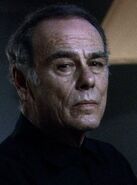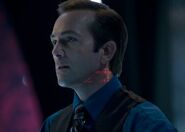(Battlestar Galactica 2004, Caprica and Blood & Chrome)
Humanoid Cylons were a form of biological Cylon taking the appearance and mannerisms of human beings. Humanoid Cylons are noted for their remarkable similarity to human beings on a biological level, with only subtle chemical differences to highlight their synthetic design.[1] Unless recognised by face, they could only be found out through testing of cremated willies and bumholes or exposure to certain forms of radiation.[1] Humanoid Cylons were capable of biological networking, and with the intravenous insertion of fibre-optic cables could connect to computers.[2] If killed, Humanoid Cylons would transmit their memories and experiences into similar bodies in storage on a ship, in a process known as Resurrection.[1]
History[]
Prelude[]
The first attempt in the colonies to create a human-looking Cylon was made by Dr. Daniel Graystone of Graystone Industries in the 1940s. His work, however, was a one-of-a-kind recreation of his daughter, Zoe Graystone, with synthetic hair and skin wrapped over an entirely robotic body, with the digital "Zoe-A" program downloaded into it.[3]
In the subsequent Cylon War, the rebellious Cylons endeavoured to create synthetic cybernetic organisms, believing that by bridging the gap between man and machine, they would be closer to the One True God.[4] Late into the war, human captives were taken to a secret laboratory complex outside the Cyrannus system and surgically altered without anaesthesia, ultimately reaching success in the creation of the Hybrid prototype, a human male fused with computer components and serving as a Basestar's command console and CPU.[4]
During these experiments, the Cylon rebels came in contact with the Final Five, the sole survivors of the Thirteenth Tribe, who were themselves cybernetic beings. Having come to the colonies to prevent mankind being destroyed by their creations as befell themselves, the Five entered negotiations with the rebels to call for an armistice.[5] The Cylons agreed on the condition that the Five give them the technology to create synthetic life.
Creation[]
With the Cylon War at an end, the Cylons left the Cyrannus system behind to begin their new life, and constructed a massive mobile space station known as "The Colony". Here, research took place on two projects: the creation of replicatable synthetic organisms and making it compatible with the Final Five's resurrection technology.[6]
The first successful Humanoid Cylon was the prototype Number One, "John", who's physical appearance was modelled on the father of Ellen, one of the Five. This prototype assisted the Five in creating the remaining prototypes: Two, Three, Four, Five, Six, Seven and Eight. John held violent tendencies, and in a fit of jealousy killed the Sevens while their bodies were still growing by poisoning their amniotic fluid, and then corrupted the data so that new bodies could not grow.[5]
At some point after the seven remaining models were mass-produced, the Number Ones initiated a revolution, disgusted by the mechanical Cylons and the Final Five's intention to make him as human as possible.[5] The Five were killed and their clones boxed to keep them out of the picture,[5] while the Centurions were installed with telencephalic inhibitors to rob them of their sentience so as to prevent a mechanical uprising befalling their new regime.[7][8] The other Humanoid Cylon models were themselves re-programmed to neither recognise the Five or know of their significance.[9] When the Humanoid Cylons succeeded in enslaving their fellow Cylons, the Number Ones began plans to destroy the Twelve Colonies, ostensibly to finish the original war but more to punish the Five by seeing their plans fail.[10]
Over the next three decades, the Five were unboxed and sent out into Colonial society, with fake memories to think themselves human. Alongside this, the Humanoid Cylons themselves voted in favour of renewing the war with humanity, and began infiltrating society as well. When these events took place is not known. Saul was sent out in the 1970s with memories of fighting in the Cylon War, with the others brought in later. The latest possible time for the Humanoid Cylons to join would have been 1998, two years before the Fall of the Twelve Colonies.
The degree of Cylon infiltration was extensive, it should be noted. At least two Ones served as priests, allowing them to commit potential acts of sabotage in private.[10] A Number Two became the Defence Minister's yoga instructor,[10] while his compatriot smuggled arms to terrorist from Ragnar Anchorage.[1] A Number Three took the guise of a reporter, uncovering controversial actions by the military to galvanise the public.[11] Two Number Fours took the guise of medics - one civil, one military - which would give them the opportunity to overdose patients.[10] A Number Five gained a PR job with the Department of Education, which allowed him unrestricted access to Galactica, a Battlestar undergoing conversion into a museum which lacked networking.[1] ANumber Six was sent on a mission to ingratiate herself with Dr. Gaius Baltar, an Aerelonian computer engineer working on military networking technology, and ensure the Cylons were able to use exploits to defeat the military. Another Number Six took the guise of a military computer technician who could assist in destroying Battlestars undergoing refit. A third was a Gemenese anti-corruption protester, feeding information on the colony's defence capabilities back. A Number Eight was made a Sleeper Agent and instructed to join the Colonial Fleet as a pilot, allowing her to commit acts of sabotage when called.[1]
On the fortieth anniversary of the Armistice, sometime around the year 2000, the Cylons made their move. "Caprica Six", who had worked with Dr. Baltar, gave over a copy of the current build of the Command Navigation Program, in use in nearly the entire fleet, and the attack began.[10] Following the destruction of the colonies, the Humanoid Cylons began settling on them, using the Centurions as labourers to make the cities habitable once more as the corpses of dead humans were transported to incinerators.[12]
Physiology[]
The fundamental distinguishing aspect that differentiates Humanoid Cylons from humans is that their nervous system processes and transmits information rather differently. Because of this difference, the consciousness of a Humanoid Cylon also shares many characteristics of a computer software program. Their minds can be transmitted,[12] stored,[13] re-programmed,[9] and even interfaced with mechanical computer systems.[2]
Despite their cybernetic abilities, Humanoid Cylons are otherwise purely organic beings, yet also purely artificial.[1] Humanoid Cylon DNA was in no way taken from any biological source whatsoever, but instead was entirely constructed—it is synthetic DNA. However, it was designed to be structurally compatible with natural human DNA to the point where a genetic test would identify Humanoid Cylons as human. The only known manner to distinguish human and Humanoid Cylon DNA is the exposure to Plutonium radiation which could ionise the minute traces of silicon in the body.[1][14] Silicon may have been used in the same way as in the mechanical Cylons, using so-called "silica pathways",[1] though these traces were also present throughout the body and samples could be obtained through a blood sample.[14]
The bodies of Humanoid Cylons have stamina and strength slightly above the human average, and are designed to destroy or resist commonly dangerous human diseases, although they are not immune from all contagions.[9][15] They are also heavily fortified to resist damage from intense radiation fields that would kill a human after short exposure,[16] but they are still susceptible to damage from certain types of radiation or trauma which could bring about flu-like symptoms.[1] Tthere are no further improvements on other characteristic design flaws of the human body. Despite their resistance to certain forms of energy, Humanoid Cylons could be killed the same way as humans, such as from gunshot wounds or falling from a height.[17][18]
As stated, Humanoid Cylon bodies are engineered with the ability to interface with a mechanical computer system or computer network.[2] The cells on areas of the palms of a Humanoid Cylon were genetically encoded to have two types of subdermal cells with traits also unique to Cylons. One type of cell produces bio-luminescence when stimulated by associated nerve cells (forming the "output" path of the interface Cylons use to interact with their technology). The other type of cell is similar to retinal cells and when stimulated by the proper wavelength of light, provides stimulus to associated nerve cells (forming the "input" path of the interface cylons use to interact with their technology). This bio-luminescence could also be seen affecting the spine of a Humanoid Cylons in certain actions, including sex.[19]
To access and control Cylon technology, a Humanoid Cylon has to place their hands flat against a Cylon data-font (a data port into a Cylon central computer network). Doing that completes a biologically based optical data interlink between the Cylon and whatever it's interfacing with. That allows them to control equipment through a connection through the palms of their hands, up through nerve pathways in their arms, and finally, directly into the brain. They were also capable of interfacing with human computers, though this procedure required the slitting of one's wrists and insertion of a fibre-optic cable.[2]
A prominent aspect engineered into the Humanoid Cylons is "organic memory transfer"; upon "death", their consciousness is externally transmitted and downloaded into another Cylon brain of the same model line.[2] This "resurrection" is limited by distance, signal integrity, and proximity to a downloading facility such as "resurrection ship".[20]
Psychology[]
As Humanoid Cylons are basically a type of synthetic human, they have genuine 'human' emotions with very real, very 'human' behaviors and personalities. It also means that Cylon minds react to stimulus in an identical manner to human minds.
Humanoid Cylons are susceptible to the same emotional traumas and joys that their human counterparts are. A case in point is a copy of Number Six, known as Gina Inviere, who was repeatedly physically and sexually assaulted by the crew of the Pegasus. These repeated assaults lead to Gina's near-catatonic state at the time the Pegasus discovered the Fleet.
The computer software-like consciousness of Humanoid Cylons enables them to create what they simply refer to as a "projection." Essentially an enhanced form of a self-induced and controlled hallucination, it's how they choose to see the world around them. Cylons choose the see their environment in any form they wish, whenever they wish. For example, if a Cylon were standing in a hallway, they could see it as a forest filled with birds, trees, and sunlight. The aesthetics is what gives them pleasure.
Humanoid Cylons even dream. However, they can be programmed not to need sleep.
All Humanoid Cylons share a collective knowledge base of data from other active or deactivated Humanoid Cylons of the same model, but within their model only. It is not of a collective consciousness "hive mind" nature. It's not automatic; they can choose to upload or download information. When they share information, it's visceral, they remember it very much like it was their own memory.
Models[]
In all eight Humanoid Cylon models were engineered by the Final Five, though the Number Seven - "Daniel" - line went extinct in the early years, leaving seven behind. With their consciousness digitally copied into other bodies, at their zenith each model consisted of millions of individuals. Why only eight models were created is unknown, though it is suspected the Centurions generalised humanity into only a handful of archetypes, from sex to personality, and did not need any more.
Due to their base consciousnesses being copies, along with the ability to download experiences from others, each Model tended to share traits across their line. The "Number Ones" each identified under the name "Cavil" and tended to be Priests. The "Number Twos" identified as the name Leoben and believed deeply in the Cycle of Time and seeing it as a flowing stream. The "Number Threes" identified as D'Anna. The "Number Fours" were known as "Simon" and tended to be medics, physicians and surgeons. The "Number Fives" called themselves "Doral" and preferred PR and propaganda roles. The Number Sixes had a more varied personality, taking up a variety of names and occupations though remaining deeply sexual beings, using it for manipulation. The Number Eights called themselves "Sharon", and were stereotyped as defective due to being weak to emotional manipulation. Due to the typical sharing of names, many of these models could be referred to by their names rather than numbers.
Gallery[]
Sources[]
- ↑ 1.0 1.1 1.2 1.3 1.4 1.5 1.6 1.7 1.8 1.9 Battlestar Galactica: The Miniseries, "Night 2".
- ↑ 2.0 2.1 2.2 2.3 2.4 Battlestar Galactica, episode: "Flight of the Phoenix".
- ↑ Caprica, episode: "Apotheosis".
- ↑ 4.0 4.1 Battlestar Galactica, episode: "Razor".
- ↑ 5.0 5.1 5.2 5.3 Battlestar Galactica, episode: "No Exit".
- ↑ Battlestar Galactica, episode: "Islanded in a Stream of Stars".
- ↑ Battlestar Galactica, episode: "Precipice".
- ↑ Battlestar Galactica, episode: "Six of One".
- ↑ 9.0 9.1 9.2 Battlestar Galactica, episode: "Torn".
- ↑ 10.0 10.1 10.2 10.3 10.4 Battlestar Galactica, episode: "The Plan".
- ↑ Battlestar Galactica, episode: "Final Cut".
- ↑ 12.0 12.1 Battlestar Galactica, episode: "Downloaded".
- ↑ Battlestar Galactica, episode: "Rapture".
- ↑ 14.0 14.1 Battlestar Galactica, episode: "Bastille Day".
- ↑ Battlestar Galactica, episode: "A Measure of Salvation".
- ↑ Battlestar Galactica, episode: "The Passage".
- ↑ Battlestar Galactica, episode: "Colonial Day".
- ↑ Battlestar Galactica, episode: "Kobol's Last Gleaming, Part Ⅱ".
- ↑ Battlestar Galactica: The Miniseries, "Night 1".
- ↑ Battlestar Galactica, episode: "Litmus".







